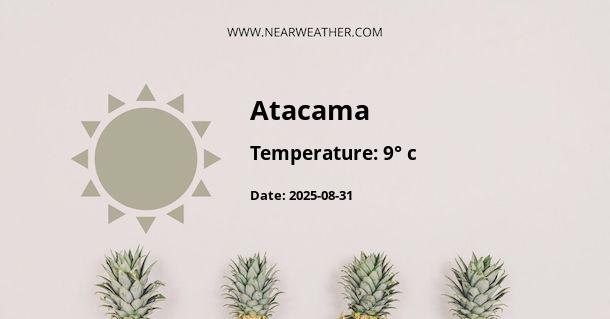## Climate and Weather in the Atacama Region, Chile The Atacama Region is located in northern Chile and is known for its unique climate and weather patterns. As one of the driest places on Earth, the region experiences a desert climate with extremely low levels of precipitation and consistently high temperatures. Understanding the weather patterns and climate of the Atacama Region is essential for anyone planning to visit or live in this area. In this article, we will explore the climate and weather of the Atacama Region throughout the year, providing valuable insights for travelers and residents alike. ### Overview of Atacama Region's Climate The Atacama Region is characterized by an arid desert climate, with minimal rainfall and high temperatures. The region is heavily influenced by the Atacama Desert, which is one of the driest places on the planet. The lack of significant vegetation and the presence of expansive salt flats contribute to the unique climate of the area. The climate is often classified as a hot desert climate (BWh) according to the Köppen climate classification, indicating extremely low precipitation and high temperatures throughout the year. ### Atacama Region Weather by Season #### Summer (December - February) During the summer months in the Atacama Region, the weather is extremely hot and dry. Average daytime temperatures often exceed 30°C (86°F), and the lack of cloud cover can lead to intense solar radiation. While temperatures can be scorching during the day, they often drop significantly at night due to the low humidity levels and clear skies. This phenomenon is known as diurnal temperature variation and is a common characteristic of desert climates. #### Autumn (March - May) Autumn in the Atacama Region brings about more moderate temperatures compared to the summer months. While daytime temperatures can still be warm, the intensity of the heat begins to diminish as the region transitions into the cooler months. The nights become longer, and the diurnal temperature range becomes less pronounced. However, the overall dry and arid conditions persist throughout the autumn season. #### Winter (June - August) Winter in the Atacama Region is characterized by mild daytime temperatures and cooler nights. Despite being a desert climate, the region experiences a noticeable drop in temperatures during the winter months, with average daytime temperatures ranging from 15°C to 20°C (59°F to 68°F). While rainfall is exceedingly rare, the winter months may occasionally experience fog and mist due to the temperature differentials between the land and the Pacific Ocean. #### Spring (September - November) As spring arrives in the Atacama Region, temperatures gradually begin to rise, signaling the transition to warmer weather. The days become longer, and the region experiences a resurgence of warmer temperatures. However, the arid conditions persist, and any precipitation remains minimal. Spring is also characterized by strong winds, which can contribute to the ongoing aridity of the region. ### Annual Weather Averages To provide a comprehensive understanding of the Atacama Region's climate, it is essential to review the annual weather averages, including temperatures and precipitation. The following table outlines the average monthly temperatures and precipitation levels in the Atacama Region: | Month | Average High (°C) | Average Low (°C) | Precipitation (mm) | |-------------|--------------------|------------------|--------------------| | January | 33.1 | 17.8 | 0.0 | | February | 32.8 | 17.3 | 0.0 | | March | 31.5 | 16.3 | 0.0 | | April | 28.7 | 14.5 | 0.0 | | May | 25.2 | 11.3 | 0.0 | | June | 22.1 | 8.6 | 0.0 | | July | 21.3 | 8.2 | 0.0 | | August | 23.0 | 8.5 | 0.0 | | September | 25.5 | 10.5 | 0.0 | | October | 28.2 | 13.2 | 0.0 | | November | 30.5 | 15.1 | 0.0 | | December | 32.5 | 17.0 | 0.0 | The data clearly demonstrates the consistent dryness of the region, with minimal precipitation recorded throughout the year. The average temperatures show the characteristic high daytime temperatures and significant diurnal temperature variations associated with desert climates. ### Extreme Weather Events While the Atacama Region is renowned for its arid and dry climate, it is not immune to extreme weather events. One notable phenomenon is the occasional occurrence of *Bolivian winter* or *altiplanic winter*. This event refers to a period of unusual and intense rainfall in the normally arid region, caused by the intrusion of a moist air mass from the Amazon Basin. These rare weather events can result in flash floods, which dramatically transform the landscape and pose significant challenges to the local infrastructure. ### Conclusion The Atacama Region's climate is undoubtedly distinctive, characterized by its arid desert conditions, minimal precipitation, and extreme daily temperature variations. Understanding the climate and weather patterns in the Atacama Region is crucial for travelers, researchers, and local residents alike. The region's unique climate not only presents scientific interest but also holds significance for environmental studies and tourism. By providing a detailed overview of the climate and weather in the Atacama Region throughout the year, this article aims to serve as a valuable resource for anyone seeking to grasp the intricacies of this remarkable region. In conclusion, the Atacama Region's climate and weather are undeniably shaped by its desert environment, with an emphasis on extraordinarily low precipitation levels and high daytime temperatures. This distinctive climate has positioned the region as a focal point for scientific research and an alluring destination for explorers seeking to witness the unparalleled beauty of one of the driest places on Earth.
A - Atacama's Latitude is -27.500000 & Longitude is -70.000000.
A - Weather in Atacama is 14° today.
A - Climate Conditions in Atacama shows clear sky today.
A - Humidity in Atacama is 64% today.
A - Wind speed in Atacama is 5.65 km/h, flowing at 303° wind direction. today.
